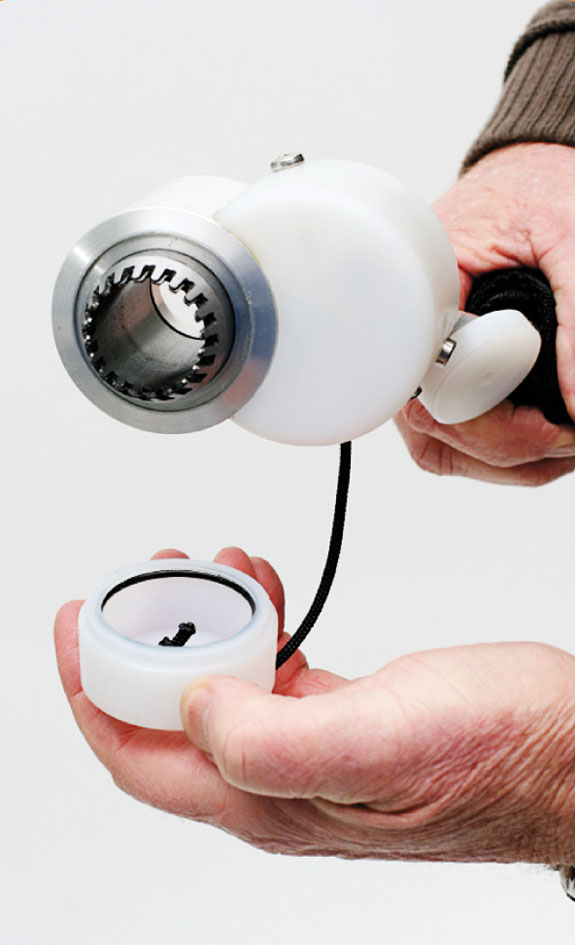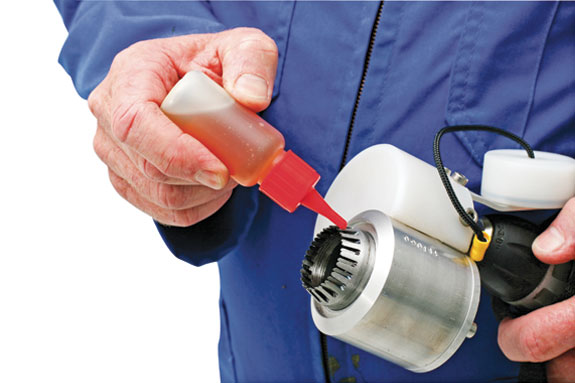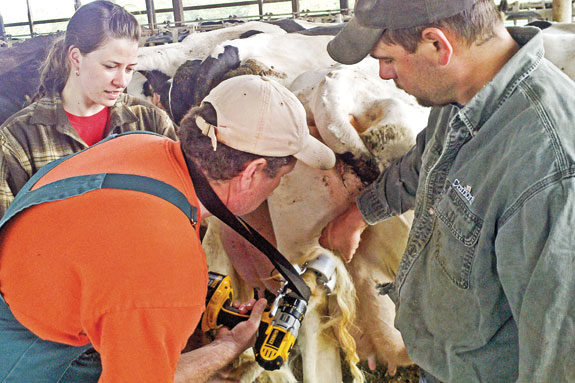It isn’t every day that a simple concept replaces a management practice that has been carried out for many years in the dairy industry. California, the country’s largest dairy state, became the first state in the U.S. to ban tail docking of dairy cattle in early 2010 as a way to improve animal welfare. When the bill was signed into law in January of 2010, California dairy producers were no longer able to “dock” or amputate the tails of dairy cattle, which created a need for other alternatives.
Since then, TailWell , an electric drill attachment developed to simplify the task of trimming the tails of milking cows, became a fit as an alternative solution to tail docking.
Although this trimmer is currently in operation on some California dairies, other states across the U.S. that do not have tail-docking laws in place are also beginning to trim tails with this trimmer.

From the land of the Kiwis
TailWell was developed and is manufactured in New Zealand by Shoof International . The trimmer was created as a way to clean a cow’s tail hair in a safe and efficient manner. It is a drill attachment that works with corded and cordless drills.
The owners of Agriviv , an animal health products provider based out of Wisconsin, became interested in the TailWell trimmer and decided to travel to New Zealand to learn more about the product.
“They really liked the idea and engineering of the trimmer because it took the same idea of an oscillating blade and placed it in a circular trimmer,” Rachel Kaehler, sales manager at Agriviv, says.
Soon after, Agriviv acquired U.S. distribution rights for the product. Kaehler says the product was successfully received in California due to the tail-docking ban.

Why trim?
“It was a consumer-driven requirement,” Kaehler says, when speaking of tail trimming as an alternative to tail docking.
The basic purpose of tail trimming is to reduce fecal and urine contamination of the milker and to reduce dirt around the rear quarters and udder of the cow.
Chris Granius, operations manager at Ebert Enterprise in Algoma, Wisconsin, says cleanliness was the reason his dairy started trimming tails.
“We stopped docking tails several years ago, and it was hard milking-wise for the guys in our parlor because the tail switches were just getting in the way,” Granius says.
How it works
Earlier this year, Agriviv partnered up with UC – Davis to conduct on-farm demonstrations in California to show how the product worked.
This trimmer, similar to regular cattle clippers, has an outer blade that oscillates over a stationary inner blade to cut tail hair.
“You start at the base of the tail, at the true end of the tailbone, and just feed the tail through,” Kaehler says.
To begin trimming, the tail is inserted into the circular trimmer. The person trimming guides the tail through the trimmer up to the point where the tail becomes wider than the trimmer.
Kaehler advises to let the drill do the work when trimming tails, instead of trying to force the tail through the trimmer. Using a normal style drill, trimming one tail takes three to four seconds. Pre-cutting of the tail switch is also unnecessary, even if the tail is very dirty.
“It doesn’t matter how dirty the tail is on the outside,” Kaehler says. “On the inside, that hair is actually fairly clean.”
The TailWell trimmer replaces the trimming of tails with scissors or regular cattle clippers.
“If you think about it, the tail is round and regular clippers are flat,” Kaehler says. “They don’t work as well and it takes a little more time to trim.”
When to trim
A difference in how the trimmer was used in New Zealand was in the location tails were trimmed on the farm. On New Zealand dairies, tail trimming was part of the milking routine. Producers trimmed the cows’ tails while they were in the parlor.
Because they are more available in the U.S., tail trimming is mostly done in lock-ups, where the cow is at eye level with the person rather than above them like they would be in a parlor situation.
She notes that some producers trim the tails before dry-off to avoid having dirty tails during the transition period.
Granius explains that on his dairy, they are currently trimming tails as his cows freshen.
“We just recently purchased the trimmer, so we’re not sure if this system is going to work or if we should add a trimming in between,” Granius says.
When the dairy’s trimmer was first purchased, his team went through and trimmed all of the cows’ tails. Ebert Enterprise currently has 1,650 milking cows and a total herd size of 1,980 animals.
Because every dairy has different protocols, the timing and number of trimmings differ depending on the producer. Kaehler explains that smaller commercial dairies sometimes will go in and trim tails up to four times a year.
“Once a year is satisfactory for trimming the tails and it’s better than not trimming at all,” Kaehler says. “Trimming two times a year is really kind of ideal.”
She explains that after a cow’s tail has been trimmed once, it will generally stay short year-round.
Operation tips
Oiling the trimmer is a must, Kaehler says. She advises to always keep the trimmer well-lubricated, especially if tails have a lot of sand in them or are wet, because it will take the trimmer more time to cut the hair.
After trimming has been completed for the day, Kaehler recommends the TailWell be disassembled and cleaned to ensure peak performance. A bolt spanner and an Allen wrench are provided to aid in disassembling the trimmer.
“It is important to make sure to take the blades apart, clean out the hair inside and wipe away any dirt that might have accumulated between the blades,” Kaehler says.
She explains that any person on the farm can trim tails, regardless of whether they have trimmed a tail before. There is no risk of injury to the cow or the operator of the trimmer.
One main recommendation for the trimmer is that it must be used with a drill that operates at 1,000 rpm, which can range from a 12-volt to 18-volt drill, she says.
Product improvements
Kaehler states that Agriviv is always looking for suggestions to improve the trimmer, especially from those using the product.
The addition of grinder paste and a bolt spanner to the product’s kit was the result of a producer’s suggestion.
“That’s research and development for us,” Kaehler says. “We’d rather have it in the hands of those actually using it, so that it is always improving.”
Another product addition came when one of Agriviv’s warehouse employees suggested adding a cap to the trimmer attachment and then taking it a step further.
“We inserted a sponge into the cap so that, if you want to oil the trimmer, all you have to do is put the cap on the blades and wiggle it around a little bit,” Kaehler says. “That will provide the blades a little extra lubrication.”
Kaehler also mentions that the trimmer can be attached to a right-angle drill, rather than a regular drill. The advantage of using a right-angle drill is that the person trimming can simply pull the trimmer upward to trim the tail, rather than having to twist and turn the tail to fit it through the trimmer.
“As a general rule, when you start turning a cow’s tail, the cow will turn its body,” Kaehler says. “Keeping that tail hanging down and not angling to the side has really helped keep the cows nice and steady and avoids us having to use a chute.”
Not just for California
“Another point we are trying to make with this product is to keep the trimmer’s cost down,” Kaehler says. “A lot of times the larger dairies go ahead and order replacement blades right away.”
The TailWell trimmer kit includes the trimmer attachment, a file to sharpen the blades, a small bottle of mechanical oil and grinding paste to help clean the trimmer. The Allen wrench and spanner are also included in the kit and replacement blades are available for purchase separately.
Kaehler states that many dairymen factor out the price for the trimmer on a cost-per-cow basis. These factors include a decrease in somatic cell count and fewer incidences of mastitis, as well as a cleaner environment for milkers.
She also points out that tail trimming is not limited to dairy producers in California, but can apply to the management practices on dairy operations across the country.
“We must have cows that stay clean, stay alive and keep putting milk in the tank,” Kaehler says. “The end goal with all of this is saving cows, because when we save cows, we save farmers.” PD
For more information on the TailWell tail trimmer, contact Rachel Kaehler at rachell@agriviv.com or (888) 466-3483 .
YOUR RESULTSWould your operation benefit from tail trimming? The following checklist can be used to determine if this new technology might be a fit for your operation.
1. Do you have cows with undocked tails on your dairy?
2. Are you looking for an alternative to tail docking?
3. Do you have a corded or cordless drill already available?
4. Do you want to provide a cleaner environment for your milkers?
5. Would you like to reduce the dirt around the udder of your cows?
6. Do you have pens with lock-ups?
7. Could tail trimming be incorporated into your operation’s protocols?
If you answered yes to five or more of these questions, this technology may be one for you to consider.
Photos courtesy of Agriviv.

-
Dario Martinez
- Assistant Editor
- Email Dario Martinez








